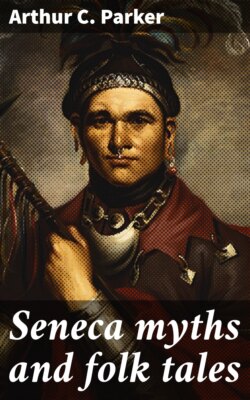Читать книгу Seneca myths and folk tales - Arthur C. Parker - Страница 32
На сайте Литреса книга снята с продажи.
5. THE SEVEN BROTHERS OF THE STAR CLUSTER.[15]
ОглавлениеTable of Contents
Seven brothers[16] had been trained as young warriors. Each day they practised in front of their mother’s lodge, but this did not please the mother. With the boys was an uncle whose custom it was to sit outside the lodge door and drum upon a water drum, that the boys might learn to dance correctly.
In time the boys became perfect in their dancing, and then announced that they were about to depart on an expedition to test their skill. The seven assembled about the war post and began their dance. They then went into their mother’s lodge and asked her to supply them with dried meat and parched corn for their journey but she sent them away, scoffing at their presumptions.
Again they danced and again returned for food. “I will not give you so much as a small cake of corn bread,” said the mother hoping to restrain them. But they went back to their dance. A third time they returned but again were repulsed.
The fourth dance started and the oldest youth changed his tune to the song of Djihaya. With great enthusiasm he sang compelling his brothers to dance a dance of magic.
Hearing the wierd music the mother rushed out of the lodge and saw her sons dancing in the air over the trees. This greatly startled her and she cried, “Return, my sons! What manner of departure is this?” But the song continued and the boys danced higher and higher.
Again the mother cried, “Oh, my eldest son, will you not return?” But the eldest son would not listen, though his heart was touched. Then the mother screamed, “Oh my eldest son, will you not hear your mother’s voice? Only look down to me!” Then was the oldest son’s heart touched very deeply, but he did not respond, for fear of making his brothers weak.
“Oh my brothers,” he called. “Heed no sounds from the earth but continue dancing. If you look down you shall fall and never more be able to dance.”
The mother now gave a heart-broken cry and called, “Oh my first born son, give your mother one look,—one last look or I die!” This weakened the heart of the oldest son and he looked down toward the figure of his mother with outstretched arms, weeping for him.
As he looked he lost his power to master the air, and began to fall. With great rapidity he fell until he struck the earth and penetrated it, leaving only a scar where the soil came together again.
The mother rushed to the spot and swept aside the rubbish, but no trace of her son could she find. Finally looking up she saw her other boys dancing far up in the sky. They had become the “dancing stars.”
In deep sorrow the mother with covered head sat beside the spot where her first born had fallen. For a whole year she wept as she watched.
Winter came and her dancing boys appeared over the council house and each night were observed overhead, but no sign of her eldest could be seen.
Came springtime and the time of budding plants. From the spot where the eldest had disappeared a tiny green shoot appeared. This the mother watched with great solicitude. It grew into a tall tree and became the first pine. This tree was guarded by the melancholy old woman and she would allow no man to touch it; she knew that it was her son and would sometime speak to her.
The winds blew and the tree swayed, it began to speak, and the mother heard. Only she could interpret the sounds that came from the waving branches, only she could see the face of the young warrior with his plumes.
A careless hunter slashed at the tree and blood flowed, but the mother bound up the wound and drove other intruders away. In time the tree bore small short feathers (cones), and more trees grew. These the hunters slashed in order to get pitch for canoes and ropes.
Every winter the pine tree talked to its dancing brothers in the sky and the mother knew that her eldest son should be her comfort while she rested on this earth.
GENERAL NOTES. This legend I had from Edward Cornplanter but being so familiar with it I made only a few rough notes which I have transcribed. This myth is similar to the Huron and Wyandot forms recounting the origin of “the cluster.”
